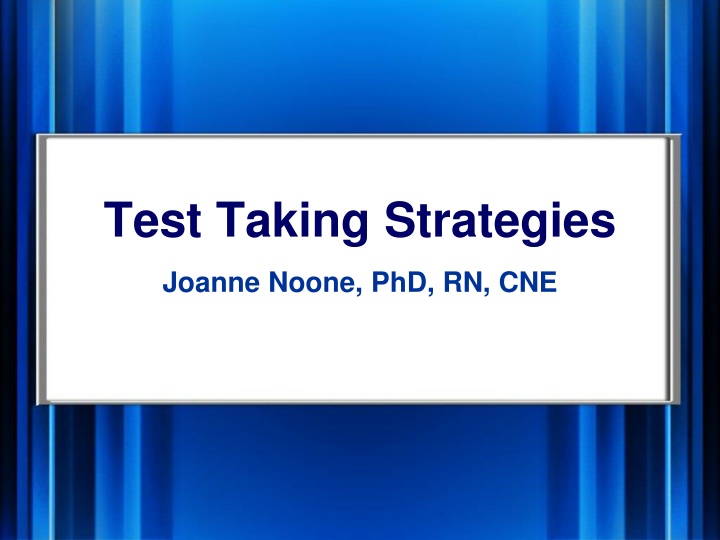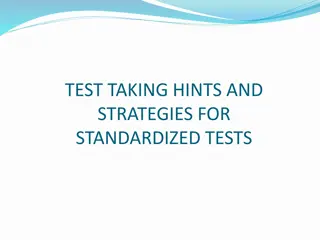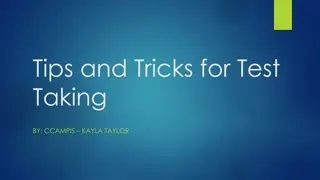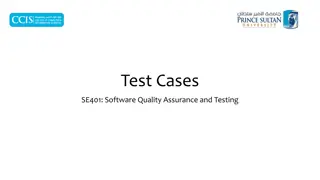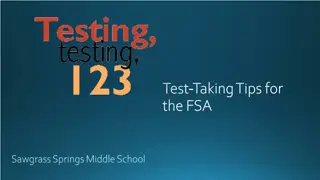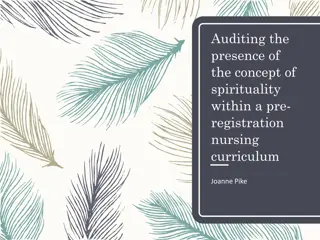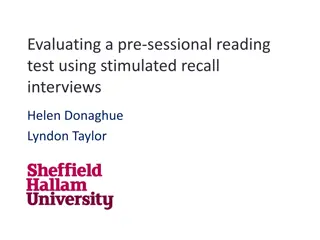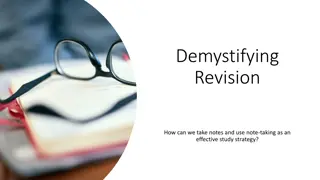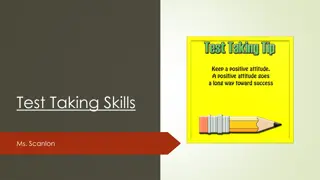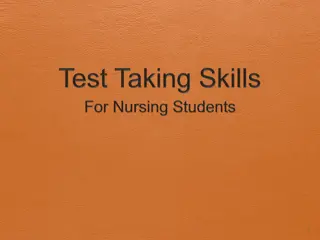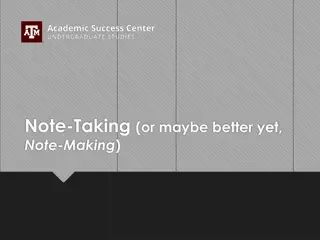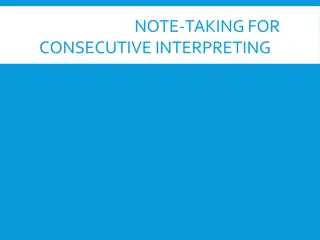Effective Test-Taking Strategies by Joanne Noone, PhD, RN, CNE
Enhance your test preparation and performance with expert advice from Joanne Noone, PhD, RN, CNE. Learn effective strategies such as identifying key elements in questions, prioritizing, and addressing scenarios correctly. Improve your test-taking skills for better academic success.
Download Presentation

Please find below an Image/Link to download the presentation.
The content on the website is provided AS IS for your information and personal use only. It may not be sold, licensed, or shared on other websites without obtaining consent from the author.If you encounter any issues during the download, it is possible that the publisher has removed the file from their server.
You are allowed to download the files provided on this website for personal or commercial use, subject to the condition that they are used lawfully. All files are the property of their respective owners.
The content on the website is provided AS IS for your information and personal use only. It may not be sold, licensed, or shared on other websites without obtaining consent from the author.
E N D
Presentation Transcript
Test Taking Strategies Joanne Noone, PhD, RN, CNE
Preparing Look for possible test questions in your notes, during lecture, text Ask Why? when studying Go to test review sessions or take reviews on Sakai Study with others and brainstorm questions Use your tutor!
Day of Exam Sleep and eat! Not the day to be running late! Read directions Check your work to avoid careless errors Leave time at the end to review that your scantron is filled in correctly Deep breathe, relax, ear plugs
Strategies 1. Identify parts of the question Prioritize Identify keywords Eliminate answers Identify what is being asked for Answer the question before reading the answers. Reword the question Do not over analyze Change your answer only when .. 2. 3. 4. 5. 6. 7. 8. 9.
Whats the scenario and what s the stem? You work with a dentist. He is overweight, 55 year-old man with no known history of heart disease. He begins to complain of sudden severe, crushing pain under his breastbone, in the center of his chest. What is the most important action to do?
Case Scenario Scenario: You work with a dentist. He is overweight, 55 year-old man with no known history of heart disease. He begins to complain of sudden severe, crushing pain under his breastbone, in the center of his chest. Stem: What is the most important action to do?
Prioritize ABCs Safety Time Maslow s Hierarchy Questions may ask: most important first action Choose ABCs over psychosocial (most times)
What is the most important action to do? a. Ask if he has heartburn and if he does, tell him to take an antacid b. Tell him to lie down and call his personal physician to report the problem c. Tell him to lie or sit quietly, then you phone 911 immediately d. Offer to drive him to the nearest Emergency Department
What is the most important action to do? a. Ask if he has heartburn and if he does, tell him to take an antacid b. Tell him to lie down and call his personal physician to report the problem c. Tell him to lie or sit quietly, then you phone 911 immediately d. Offer to drive him to the nearest Emergency Department
What are the keyword(s)? You and a few coworkers are returning to your workplace after lunch. You leave your coworkers in the hallway and walk into the office. You find your 50 year-old supervisor slumped over her desk. You gently shake her and shout Are you OK? She is unresponsive. Which of the following actions should you do next?
What are the keyword(s)? You and a few coworkers are returning to your workplace after lunch. You leave your coworkers in the hallway and walk into the office. You find your 50-year-old supervisor slumped over her desk. You gently shake her and shout Are you OK? She is unresponsive. Which of the following actions should you do next?
Eliminate 2 Answers What should you do next? a. Open the airway using the head tilt-chin lift method b. Shout for help c. Look for signs of circulation d. Run downstairs to the security station and phone 911
Eliminate 2 Answers What should you do next? a. Open the airway using the head tilt-chin lift method b. Shout for help c. Look for signs of circulation d. Run downstairs to the security station and phone 911
What should you do next? 1. Open the airway using the head tilt- chin lift method 2. Shout for help
What should you do next? 1. Open the airway using the head tilt- chin lift method 2. Shout for help
What to do if there seems like no one right answer? Look at each choice; are some only partly true or true in limited situations Imagine each choice as being the right answer within the situation and determine if that looks correct as you are seeing it act out
Answering negative questions Identify key words Answer the item that is wrong You may know this as: All of the following EXCEPT: Stem may now ask or say: Which is least helpful Further teaching is required
Is this asking for a right or wrong answer? A student in a CPR class is asked about signs of circulation. Which response would indicate that further teaching is required? a. Normal breathing b. Blue, cool skin c. Coughing d. Movement
A student in a CPR class is asked about signs of circulation. Which response would indicate that further teaching is required? 1. Normal breathing 2. Blue, cool skin 3. Coughing 4. Movement
A student in a CPR class is asked about signs of circulation. Which response would indicate that further teaching is required? 1. Normal breathing 2. Blue, cool skin 3. Coughing 4. Movement
Answer the question before looking at choices Which of the following is a cardiac risk factor that can be modified?
Which of the following cardiac risk factors can be modified? 1. Family history 2. Gender 3. Race 4. Smoking
Which of the following cardiac risk factors can be modified? 1. Family history 2. Gender 3. Race 4. Smoking
Reword the question Which of the following are signs that you should attach the AED?
Reword the question What are signs of cardiac arrest?
Which of the following are signs that you should attach the AED? a. Facial droop, arm weakness, speech abnormalities b. Chest pain, lightheadedness, sweating, and nausea c. No response, no normal breathing and no signs of circulation d. No response, normal breathing, and pale skin
Do not overanalyze Do not read into questions information that is not there All the information you need to answer the question in in the scenario If you find yourself asking Well, what if , you are overanalyzing!
A note about changing answers Mark and review questions you are unsure of Only change your answer if upon reflection you have a higher certainty that another answer is correct Most of the time your first choice is correct but changing your answer with good certainty can be helpful
Strategies 1. Identify parts of the question Prioritize Identify keywords Eliminate answers Identify what is being asked for Answer the question before reading the answers. Reword the question Do not over analyze Change your answer only when .. 2. 3. 4. 5. 6. 7. 8. 9.
